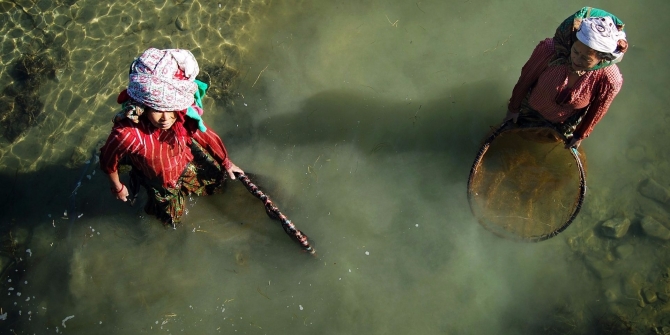 Although Indian PM Narendra Modi’s electoral campaign has attracted endless analysis, his diaspora engagement remains relatively understudied. But Saanya Gulati writes that his speeches to Indians living abroad offer a useful case study on nation branding. She offers examples of how consistent messaging has been packaged for different audiences, and explores the rationale behind cultivating these audiences.
Although Indian PM Narendra Modi’s electoral campaign has attracted endless analysis, his diaspora engagement remains relatively understudied. But Saanya Gulati writes that his speeches to Indians living abroad offer a useful case study on nation branding. She offers examples of how consistent messaging has been packaged for different audiences, and explores the rationale behind cultivating these audiences.
On 28 September 2014 the Indian Prime Minister made history in New York’s Madison Square Garden, where he delivered an hour-long speech to over 20,000 attendees. Many of those in the audience were Indians who had settled overseas, the diaspora community. From dance performances and blaring Bollywood music to Modi masks, the fanfare – which was in no shortage that night – soon became characteristic of the Prime Minister’s rock-star like speeches that he went on to deliver to diaspora communities around the world.

Much has been said about Modi’s electoral campaign, from its well-crafted slogans to its fine-tuned digital strategy, but his diaspora engagement remains relatively understudied. This is surprising considering the parallels that the two share. If Modi’s electoral campaign was a practical exercise in personal political branding, then his diaspora engagement makes for a good case study on nation branding, the practice of managing and controlling the image that governments project to the world.
Nation branding is not an unprecedented phenomenon in India. But its scale, method of delivery, and messaging are distinct under the Modi regime. Between September 2014 and March 2016 Modi delivered 12 speeches in 11 countries. Two of these were in United States (New York and San Jose), as the country has a sizeable Indian community on either coast –1.6 million in total according to the NRIOL). The only leader with a comparable style of direct foreign policy was Jawaharlal Nehru, India’s first Prime Minister, whom Modi has ironically been rather critical of.
Modi’s promise of Modern India
As far as the messaging of brand India under Modi is concerned, it can be captured in a single world: change. Similar to his electoral campaign, change is the predominant message in Modi’s speeches to the diaspora. But this time change is not about voting in a new government, it is about a changed India under the Modi government: a brand that is being mass-marketed to the diaspora under Modi’s premiership.
Modi’s promise of building a modern India is the key offering of the brand, and the key mechanism through which the idea of change is communicated. Across his speeches, the pursuit of modernity is presented as a desirable, and, inevitable goal.
“To make a modern India, and to make a Digital India, we [the Government and I] are working day and night,” he tells his audience in Dubai, whereas in Singapore he states, “it is not enough that India moves forward, it is necessary for India to become modern.” A similar slogan is packaged to the Malaysian audience where he claims “we are eradicating poverty, by giving our people the fruits of a modern economy.”
Modern India is also ruthlessly juxtaposed against its less desirable, almost dreaded, opponent: tradition, in order to make the brand promise more enticing. Modi’s memorable mouse-snake metaphor at Madison is a quintessential example of this. Here, he tells the diaspora that if they had not done ‘wonders’ in the area of Information Technology,
“[India] would have still been considered the country of snakes and snake-charmers […] our country has changed […] our ancestors used to play with snakes, but we play with the mouse.”
In San Jose, he plays on a similar motif, where he emphatically declares that,
“the old ways and ideas that were associated with India have now changed…those who refuse to change are going to be irrelevant in the 21st century.”
Complex nation, simple brand
While the messages are loud and clear, it is worth considering that any nation branding exercise, far from being a banal one, comes with its own set of repercussions. The first one is the inherent dichotomy in the concept itself. While nations are historically complex constructs, branding is conversely a process of simplification, for content to be consumed easily, and comprehended quickly. As Melissa Aronczyk, a nation-branding scholar puts it, “branding cannot account for the plurality of voices, legacies and competing visions of the nation-state.”
In the context of Modi’s overseas visits, this statement hits home, where amidst the din of his fervent supporters wildly cheering his name at stadiums overseas, exists an equally loud voice of protestors that are against the ideology he espouses, and in particular, his tainted history. While anti-Modi protests have erupted in several cities that he has visited, an exceptionally outspoken example is that of an activist group in the UK that projected an image of Modi brandishing a sword with the Swastika in the background with the phrase “Modi Not Welcome” on the UK Parliament building a few days before his visit.
More pertinent than the overt display resistance from those who are unlikely to ever become Modi loyalists, however, is the PM’s more subtle efforts to downplay and kind of dissent or differences evident in his discourses to the diaspora. There are many problems in our country, but their solution lies in a single medicine […] development,” he tells his Canadian audience, just a month after his party banned the sale of beef in a number of Indian states, in an attempt to impose a majoritarian version of Hindu nationalism in the political domain. In the UK, he anecdotally relays conversations with leaders of other countries who reportedly ask him, “how do you handle 125 crore (1.2 billion) people living in a country so integrated, with so much love and unity?” The fact that this was during a period when several international publications were pointing toward increased intolerance in Indian society is conveniently ignored.
The quest for an outcome
Modi’s choice of target audience for his version of brand India is not unusual. The diaspora has little concern for the country’s humdrum daily news, or the more nuanced socio-political fabric of India. They are also more receptive to simple messages of change, considering they left the country to seek exactly that. Even more relevant for Modi is the longstanding association between the RSS (Rashtriya Swayamsevak Sangh), the right-wing Hindu nationalist group and predecessor of his political party, the BJP (Bharatiya Janata Party), and the diaspora. Although Modi as Prime Minister has sought to maintain some distance from the RSS and its Hindu nationalist ideology, there is no doubt that continues to benefit from the overseas support base that it has built.
The striking difference when comparing Modi’s diaspora diplomacy to his political campaign in 2014 is that there is no resounding electoral victory, or particularly noteworthy outcome for that matter. But its speculation is what makes the question an interesting one. For instance, even if the sole objective of diaspora engagements was greater investments from overseas Indians, which is certainly one of the intended outcomes, diaspora outreach could have well been the prerogative of the External Affairs Minister. Especially considering the captive audience that the diaspora represents, both for a brand built around a modernised India, and the BJP at large.
But Modi’s rationale for being the face of this brand may not stem from the diaspora, but the need to save his own face among the international community. After all, it was just a decade ago that he was practically a pariah, to the governments of the USA and UK who either banned from entering the country, or shunned during his visits. So, while the Modi brand may be a harder one to sell internationally, a glossy image of modern India certainly seems like a suitable alternative. And convincing people of the need for change may be the perfect starting point – for refusal to accept this in all likelihood signals a refusal to accept him.
This article gives the views of the author, and not the position of the South Asia @ LSE blog, nor of the London School of Economics. Please read our comments policy before posting.
About the Author
 Saanya Gulati is an MSc Candidate in Politics and Communications at LSE. Her interest in Indian politics stems from her professional background in public policy, and media. She brings diverse experiences from working as a legislative aide to a Parliamentarian to managing digital media campaigns for political parties and elected representatives. She is a passionate writer an blogs on contemporary politics and culture at www.saanyagulati.com. You can also follow her on Twitter at @BombayDelhiGirl.
Saanya Gulati is an MSc Candidate in Politics and Communications at LSE. Her interest in Indian politics stems from her professional background in public policy, and media. She brings diverse experiences from working as a legislative aide to a Parliamentarian to managing digital media campaigns for political parties and elected representatives. She is a passionate writer an blogs on contemporary politics and culture at www.saanyagulati.com. You can also follow her on Twitter at @BombayDelhiGirl.







